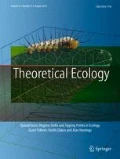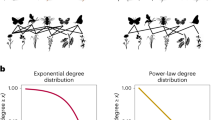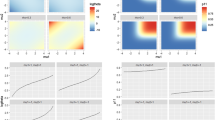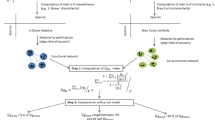Abstract
The study of species co-occurrences has been central in community ecology since the foundation of the discipline. Co-occurrence data are, nevertheless, a neglected source of information to model species distributions and biogeographers are still debating about the impact of biotic interactions on species distributions across geographical scales. We argue that a theory of species co-occurrence in ecological networks is needed to better inform interpretation of co-occurrence data, to formulate hypotheses for different community assembly mechanisms, and to extend the analysis of species distributions currently focused on the relationship between occurrences and abiotic factors. The main objective of this paper is to provide the first building blocks of a general theory for species co-occurrences. We formalize the problem with definitions of the different probabilities that are studied in the context of co-occurrence analyses. We analyze three species interactions modules and conduct multi-species simulations in order to document five principles influencing the associations between species within an ecological network: (i) direct interactions impact pairwise co-occurrence, (ii) indirect interactions impact pairwise co-occurrence, (iii) pairwise co-occurrence rarely are symmetric, (iv) the strength of an association decreases with the length of the shortest path between two species, and (v) the strength of an association decreases with the number of interactions a species is experiencing. Our analyses reveal the difficulty of the interpretation of species interactions from co-occurrence data. We discuss whether the inference of the structure of interaction networks is feasible from co-occurrence data. We also argue that species distributions models could benefit from incorporating conditional probabilities of interactions within the models as an attempt to take into account the contribution of biotic interactions to shaping individual distributions of species.

Similar content being viewed by others
References
Aráujo MB, Luoto M (2007) The importance of biotic interactions for modelling species distributions under climate change. Glob Ecol Biogeogr 16(6):743–753
Aráujo MB, Rozenfeld A (2014) The geographic scaling of biotic interactions. Ecography 37(5):406–415
Aráujo MB, Rozenfeld A, Rahbek C, Marquet PA (2011) Using species co-occurrence networks to assess the impacts of climate change. Ecography 34(6):897–908
Baselga A, Aráujo MB (2009) Individualistic vs community modelling of species distributions under climate change. Ecography 32(1):55–65
Bell G (2005) The co-distribution of species in relation to the neutral theory of community ecology. Ecology 86(7):1757–1770
Berlow EL, Dunne JA, Martinez ND, Stark PB, Williams RJ, Brose U (2009) Simple prediction of interaction strengths in complex food webs. Proc Natl Acad Sci U S A 106(1):187–191
Boulangeat I, Gravel D, Thuiller W (2012) Accounting for dispersal and biotic interactions to disentangle the drivers of species distributions and their abundances. Ecol Lett 15(6):584–593
Chamberlain SA, Bronstein JL, Rudgers JA (2014) How context dependent are species interactions? Ecol Lett 17:881–890
Clark JS, Gelfand AE, Woodall CW, Zhu K (2014) More than the sum of the parts: forest climate response from joint species distribution models. Ecol Appl: A publication of the Ecological Society of America 24(5):990–999
Connor EF, Simberloff D (1979) The assembly of species communities: chance or competition? Ecology 60(6):1132
Davis AJ, Jenkinson LS, Lawton JH, Shorrocks B, Wood S (1998) Making mistakes when predicting shifts in species range in response to global warming. Nature 391(6669):783–786
Diamond JM (1975) Assembly of species communities. In: Ecology and evolution of communities, pp 342–444
Diamond JM, Gilpin ME (1982) Examination of the null model of connor and simberloff for species co-occurrences on islands. Oecologia 52(1):64–74
Fordham DA, Akakaya HR, Brook BW, Rodríguez A, Alves PC, Civantos E, Triviño M, Watts MJ, Aráujo MB (2013) Adapted conservation measures are required to save the iberian lynx in a changing climate. Nat Clim Chang 3(10):899–903
Gotelli NJ, Graves GR (1996) Null models in ecology, vol 14, p 368
Gotelli NJ, Graves GR, Rahbek C (2010) Macroecological signals of species interactions in the danish avifauna. Proc Natl Acad Sci U S A 107(11):5030–5035
Gravel D, Massol F, Canard E, Mouillot D, Mouquet N (2011) Trophic theory of island biogeography. Ecol Lett 14(10):1010–1016
Gravel D, Poisot T, Albouy C, Velez L, Mouillot D (2013) Inferring food web structure from predator-prey body size relationships. Methods Ecol Evol 4(11):1083–1090
Guisan A, Thuiller W (2005) Predicting species distribution: offering more than simple habitat models. Ecol Lett 8(9):993–1009
Hairston NG, Smith FE, Slobodkin LB (1960) Community structure, population control, and competition. Am Nat 94(879):421
Harris DJ (2015) Estimating species interactions from observational data with markov networks. Biorix preprint. doi:10.1101/018861
Holt RD, Barfield M (2009) Trophic interactions and range limits: the diverse roles of predation. Proceedings. Biol Sci/The Royal Society 276(1661):1435–1442
Hubbell SP (2001) The unified neutral theory of biodiversity and biogeography (MPB-32). Monographs in population biology. Princeton University Press, Princeton
Hutchinson GE (1957) Concluding remarks. Cold Spring Harb Symp Quant Biol 22:415–427
Jabot F, Bascompte J (2012) Bitrophic interactions shape biodiversity in space. Proc Natl Acad Sci U S A 109(12):4521–4526
Kissling WD, Dormann CF, Groeneveld J, Hickler T, Kühn I, McInerny GJ, Montoya JM, Römermann C, Schiffers K, Schurr FM, Singer A, Svenning J-C, Zimmermann NE, O’Hara RB (2012) Towards novel approaches to modelling biotic interactions in multispecies assemblages at large spatial extents. J Biogeogr 39:1–16
Legendre P, Legendre L (2012) Numerical ecology, 3rd edn. Elsevier, Amsterdam
MacArthur RH (1972) Geographical ecology, vol 54, chap 6. Princeton University Press, Princeton, pp 460–461
MacArthur RH, Wilson EO (1967) Theory of island biogeography. Princeton landmarks in biology, vol 1. Princeton University Press, Princeton, p 203
Milo R, Shen-Orr S, Itzkovitz S, Kashtan N, Chklovskii D, Alon U (2002) Network motifs: simple building blocks of complex networks. Science 298(5594):824–827
Montoya JM, Woodward G, Emmerson MC, Solé RV (2009) Press perturbations and indirect effects in real food webs. Ecology 90(9):2426–2433
Morales-Castilla I, Matias MG, Gravel D, Aráujo MB (2015) Inferring biotic interactions from proxies. Trends Ecol Evol 30(6):347–356
Oksanen L, Fretwell SD, Arruda J, Niemela P (1981) Exploitation ecosystems in gradients of primary productivity. Am Nat 118(2):240
Ovaskainen O, Hottola J, Shtonen J (2010) Modeling species co-occurrence by multivariate logistic regression generates new hypotheses on fungal interactions. Ecology 91(9):2514–2521
Pellissier L, Rohr RP, Ndiribe C, Pradervand J-N, Salamin N, Guisan A, Wisz M (2013) Combining food web and species distribution models for improved community projections. Ecol Evol 3(13):4572–4583
Peterson AT (2011) Ecological niche conservatism: a time-structured review of evidence. J Biogeogr 38(5):817–827
Pielou DP, Pielou EC (1968) Association among species of infrequent occurrence: the insect and spider fauna of polyporus betulinus (bulliard) fries. J Theor Biol 21(2):202–216
Poisot T, Canard E, Mouillot D, Mouquet N, Gravel D, Jordan F (2012) The dissimilarity of species interaction networks. Ecol Lett 15(12):1353–1361
Pollock LJ, Tingley R, Morris WK, Golding N, O’Hara RB, Parris KM, Vesk PA, McCarthy MA (2014) Understanding co-occurrence by modelling species simultaneously with a joint species distribution model (jsdm). Methods Ecol Evol 5(5):397–406
Rohr RP, Scherer H, Kehrli P, Mazza C, Bersier L-F (2010) Modeling food webs: exploring unexplained structure using latent traits. Am Nat 176(2):170–177
Stone L, Roberts A (1990) The checkerboard score and species distributions. Oecologia 85(1):74–79
Stouffer DB (2010) Scaling from individuals to networks in food webs. Funct Ecol 24(1):44–51
Stouffer DB, Bascompte J (2010) Understanding food-web persistence from local to global scales. Ecol Lett 13(2):154–161
Stouffer DB, Camacho J, Jiang W, Amaral LAN (2007) Evidence for the existence of a robust pattern of prey selection in food webs. Proceedings. Biol Sci/The Royal Society 274(1621):1931–1940
Thuiller W, Mnkemller T, Lavergne S, Mouillot D, Mouquet N, Schiffers K, Gravel D (2013) A road map for integrating eco-evolutionary processes into biodiversity models. Ecol Lett 16:94–105
Ulrich W, Gotelli NJ (2013) Pattern detection in null model analysis. Oikos 122(1):2–18
Veech JA (2013) A probabilistic model for analysing species co-occurrence. Glob Ecol Biogeogr 22(2):252–260
Williams RJ, Martinez ND (2000) Simple rules yield complex food webs. Nature 404(6774):180–183
Wootton JT (1994) The nature and consequences of indirect effects in ecological communities. Annu Rev Ecol Syst 25(1):443–466
Yodzis P (1988) The indeterminacy of ecological interactions as perceived through perturbation experiments. Ecology 69(2):508–515
Acknowledgments
This work was inspired by discussions with T. Poisot, D. Stouffer, A. Cyrtwill, and A. Rozenfield. Thanks to Matt Talluto and Isabelle Boulangeat for helpful comments on a previous version of the manuscript. We are also thankful to Lia Hemerik for providing advice that greatly improved the manuscript. Financial support was provided by the Canada Research Chair program and a NSERC-Discovery grant to D. Gravel. M. Araújo acknowledges support from Imperial Colege’s Grand Challenges in Ecosystems and Environment Initiative.
Author information
Authors and Affiliations
Corresponding author
Additional information
Kévin Cazelles and Dominique Gravel contributed equally to this work.
Rights and permissions
About this article
Cite this article
Cazelles, K., Araújo, M.B., Mouquet, N. et al. A theory for species co-occurrence in interaction networks. Theor Ecol 9, 39–48 (2016). https://doi.org/10.1007/s12080-015-0281-9
Received:
Accepted:
Published:
Issue Date:
DOI: https://doi.org/10.1007/s12080-015-0281-9




